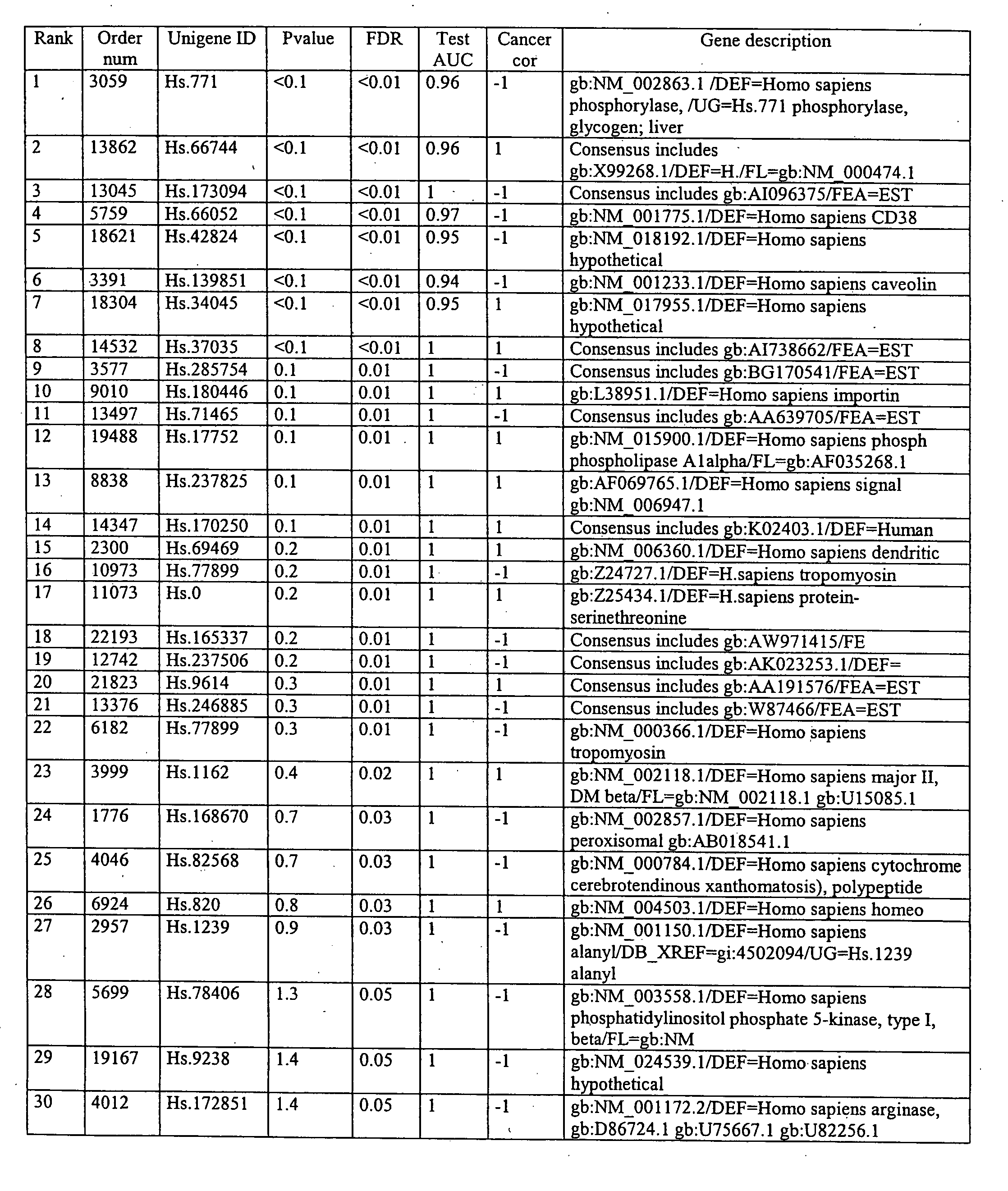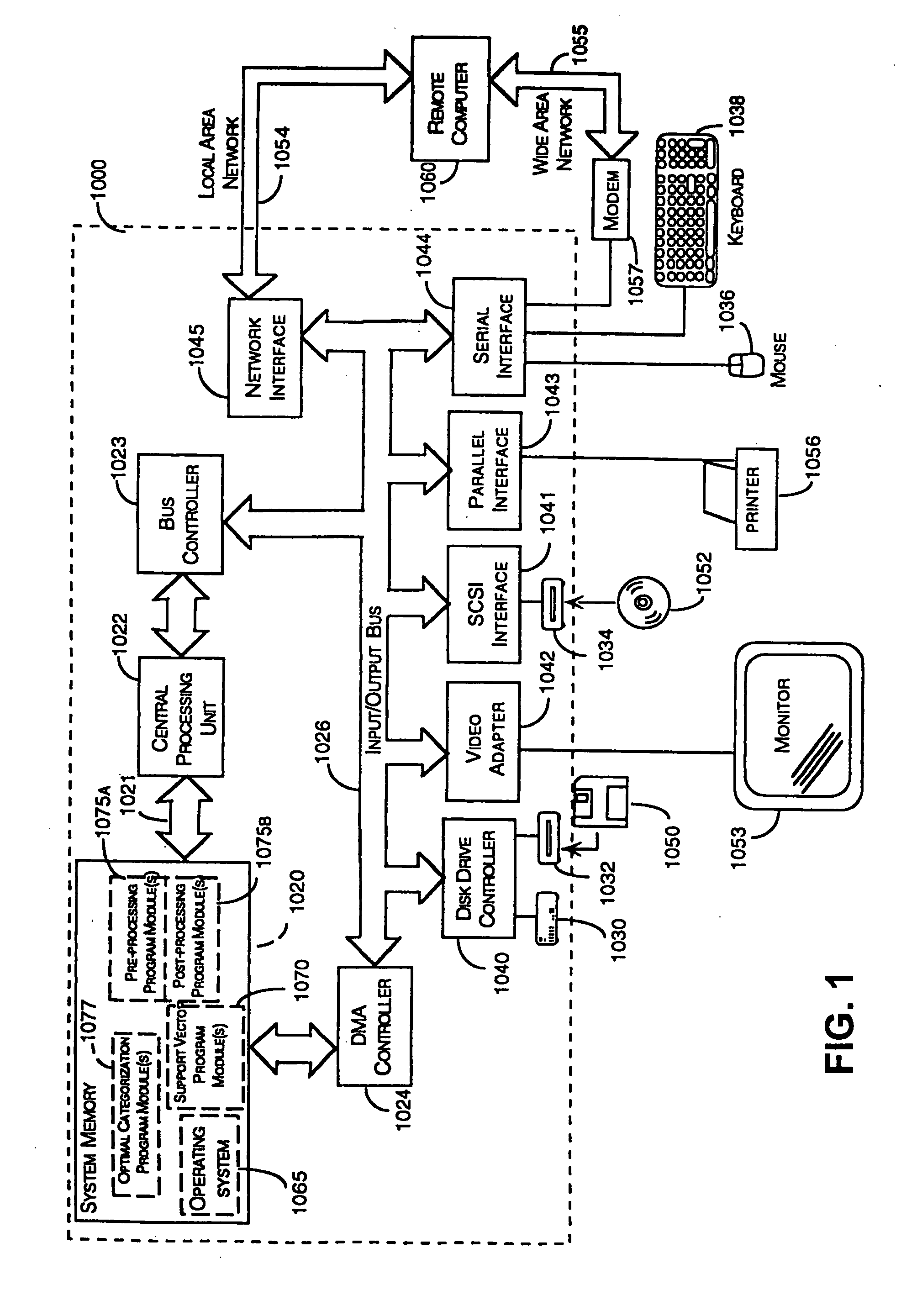Biomarkers for screening, predicting, and monitoring prostate disease
a biomarker and prostate cancer technology, applied in the field of biomarkers for screening, predicting, and monitoring prostate cancer, can solve the problems of psa being a poor predictor, affecting the quality of psa, and current analytical methods limited in their ability to manage the large amount of data generated by these technologies, so as to enhance the ability of learning machines to discover knowledge, and improve the quality of generalizations
- Summary
- Abstract
- Description
- Claims
- Application Information
AI Technical Summary
Benefits of technology
Problems solved by technology
Method used
Image
Examples
example 1
Isolation of Genes Involved with Prostate Cancer
[0079] Using the methods disclosed herein, genes associated with prostate cancer were isolated. Various methods of treating and analyzing the cells, including SVM, were utilized to determine the most reliable method for analysis.
[0080] Tissues were obtained from patients that had cancer and had undergone prostatectomy. The tissues were processed according to a standard protocol of Affymetrix and gene expression values from 7129 probes on the Affymetrix U95 GeneChip® were recorded for 67 tissues from 26 patients.
[0081] Specialists of prostate histology recognize at least three different zones in the prostate: the peripheral zone (PZ), the central zone (CZ), and the transition zone (TZ). In this study, tissues from all three zones are analyzed because previous findings have demonstrated that the zonal origin of the tissue is an important factor influencing the genetic profiling. Most prostate cancers originate in the PZ. Cancers origi...
example 2
Analyzing Small Data sets with Multiple Features
[0118] Small data sets with large numbers of features present several problems. In order to address ways of avoiding data overfitting and to assess the significance in performance of multivariate and univariate methods, the samples from Example 1 that were classified by Affymetrix as high quality samples were further analyzed. The samples included 8 BPH and 9 G4 tissues. Each microarray recorded 7129 gene expression values. The methods described herein can use the ⅔ of the samples in the BHP / G4 subset that were considered of inadequate quality for use with standard methods.
[0119] The first method is used to solve a classical machine learning problem. If only a few tissue examples are used to select best separating genes, these genes are likely to separate well the training examples but perform poorly on new, unseen examples (test examples). Single-feature SVM performs particularly well under these adverse conditions. The second metho...
example 3
Prostate Cancer Study on Affymetrix Gene Expression Data (09-2004)
[0169] A set of Affymetrix microarray GeneChip® experiments from prostate tissues were obtained from Professor Stamey at Stanford University. The data statistics from samples obtained for the prostate cancer study are summarized in Table 13. Preliminary investigation of the data included determining the potential need for normalizations. Classification experiments were run with a linear SVM on the separation of Grade 4 tissues vs. BPH tissues. In a 32×3-fold experiment, an 8% error rate could be achieved with a selection of 100 genes using the multiplicative updates technique (similar to RFE-SVM). Performances without feature selection are slightly worse but comparable. The gene most often selected by forward selection was independently chosen in the top list of an independent published study, which provided an encouraging validation of the quality of the data.
TABLE 13Prostate zoneHistological classificationNo. of ...
PUM
| Property | Measurement | Unit |
|---|---|---|
| volume | aaaaa | aaaaa |
| structure | aaaaa | aaaaa |
| nucleic acid analysis | aaaaa | aaaaa |
Abstract
Description
Claims
Application Information
 Login to View More
Login to View More - R&D
- Intellectual Property
- Life Sciences
- Materials
- Tech Scout
- Unparalleled Data Quality
- Higher Quality Content
- 60% Fewer Hallucinations
Browse by: Latest US Patents, China's latest patents, Technical Efficacy Thesaurus, Application Domain, Technology Topic, Popular Technical Reports.
© 2025 PatSnap. All rights reserved.Legal|Privacy policy|Modern Slavery Act Transparency Statement|Sitemap|About US| Contact US: help@patsnap.com



